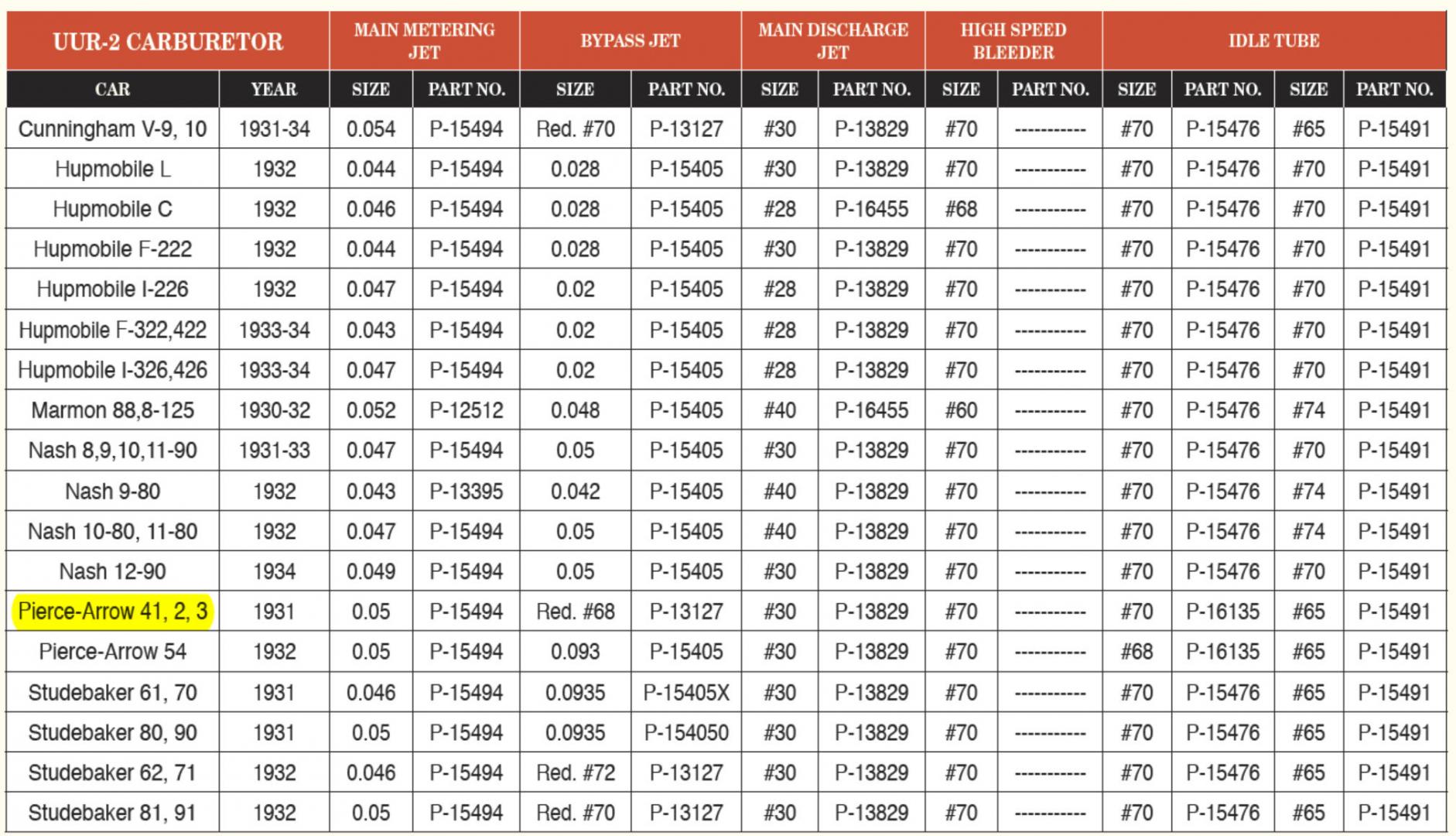- Home
- About Us
- Join/Renew
- Member Benefits
- Member Pages
- Log In
- Help
- Museum Store
Tagged: Unleaded
Series 43: my car’s jets are 0.046; anyone know if this is correct for this model?
Randy,
This came from PASB 2023-6. There is some other UU 2 information in that issue. Also check 89-5 and 1990-6 pg 9 The Broodmoor cars had .046 jets for high altitude use, see 72-1 pg 7. There are a lot of articles on the UU 2 carbs in other Bulletins. Do a search in the technical search tool with just UU 2 Carburetor in the Title box.
Dave

OK thanks, Dave. I was not certain but I assumed a larger number/diameter meant richer. Seems that is correct.
My 1931 Model 43 has .050 jets and they seem to run well at sea level. I had a copy of that chart and checked everything internally so I knew it was the right carburetor for the car.
Thanks! I think I will try to find a pair of 0.050 jets for my car.
Randy:
Are you able to get non-oxygenated, or non-ethanol fuel where you’re located? Ethanol fuels will require more jetting consideration, unless this table reflects air/fuel mixtures for the current fuels available to us. There’s a lot ventured on PAS and the AACA about what was, and what is now available to us in terms of fuels/quality, and the need to increase jetting to suit the ethanol stuff.
For my Model B, the mains are .046, and I run non-oxy fuel and either a light mix of Marvel’s Mystery Oil, or Amsoil Saber. The engine seems to run well with this setup, but I haven’t done any further combustion testing and should. My understanding is that some members like their carbs set up for touring, when the possibility of ethanol fuel may be the only option. I’m sure others will weigh-in…
-Carl
Hi, Carl. Fuel without added ethanol is easily available here. I use it or 100 octane LL from the airport when I can.
Favor the non-oxy gas from your local station, versus the airport fuel. No need for 100 octane or the TEL in a Pierce. 100 octane is overkill for our ’30s cars that probably saw 50 octane or less when new, and you’ll pay more for the aviation brew that will leave lead residue on the piston crowns, and likely foul your plugs if you don’t clean or replace them on a schedule.
I honestly don’t know why LL fuels are still in use for current production Lycomings and Continentals and other GA stuff that I service at the hangar. Perhaps it’s just that FAA matters are staid. The compression ratios in our Pierces is pretty tame, 5:1 or so. These straight 8s have more in common with tractors, as they are overbuilt and see lower RPMs, so they last a long time when they’re properly maintained…and even when they aren’t… (I doubt future generations will see a current luxury production car running the distance in the year 2120 or thereabouts.)
Carl,
The only reason I am aware of to use Avgas in our old cars is that it will go several years without deterioration unlike modern Mogas. It is good for long term storage.
There are several competing companies working on an unleaded avgas. Of course politics has gotten involved which has slowed progress down. The FAA has approved an STC for one unleaded avgas in all piston aviation engines. It’s only a matter of time when all avgas will be unleaded. I believe that the EPA has set a date of 2030 for the elimination of low lead. There also is a lawsuit here in California that may push this up.
Dave
<p style=”text-align: left;”>According to some Stromberg instructions I have read, it is pretty-much expected to need a little choke during the warm-up so with further checks like the ignition timing I may be normal. I suspect my car’s carb heat valve may be stuck closed as well.
As for avgas: as Dave stated, it is high quality and resists deterioration during storage. It is made with a refining process somewhat different from motor fuel. There is obviously no need for high-octane nor for lead in a Pierce-Arrow.</p>
Yes, the LL/UL conversation has been going on for quite some time, but there’s no question about the merits of the former for long-term storage…
Randy: are you able to remove the pipe plug on your exhaust manifold and snake an inspection camera so that you can see the carb heat valve? I had to do this on my Model B.
https://pierce-arrow.org/forums/topic/manifold-heater-valve/
Some lead or Redline sodium additive is a good idea to prevent valve seat recession of your prewar low compression engine if it is driven at highway speeds for significant periods. Probably not needed for more relaxed driving. This was an ongoing debate in the 90’s with a lot of misunderstanding with many Pierce-o-philes claiming Pierces were immune. I did some in depth technical research and published articles in CCCA and Packard Cormorant in the ’90’s. After it appeared Eric Rosenau and a few others contacted me saying some Pierces had bad valve recession after long highway trips. My updated PASB article going into this can be viewed on this site as PASB 2016-3.
I used to get jerry cans of 145 octane purple after the Reno Air races or 100LL to use as an additive to get a minimum .1 gram per gallon in the tank. 100LL had 2 grams/gallon TEL, low jead relative to 145 purple that had 4.6 grams/gallon. When leaded regular was being phased out in the ’80’s it was limited to .1 gram/gallon, the minimum to prevent valve seat recession without hardened seats. Switched to Redline sodium when it became dicey getting avgas at the airport.
